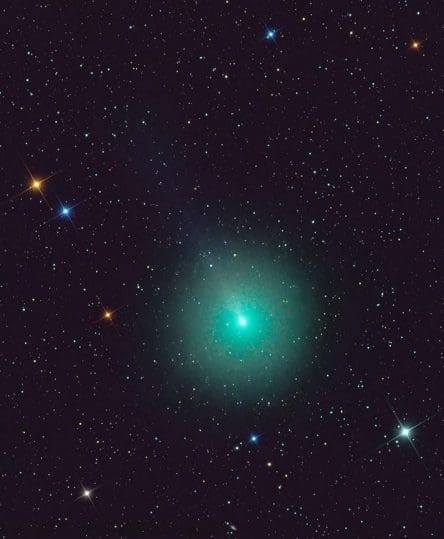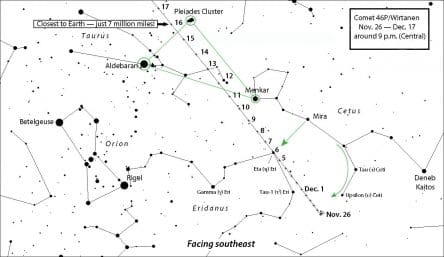December 2018 Feature – Cosmic Lights for Holiday Nights

What would December’s holiday season be without festive light displays? Well, with the exception of a few Scrooges and Grinches, most of us would say not very festive at all. I guess you could say that we are rather fortunate this year since an otherwise uncaring universe is bestowing upon us, not one, but two celestial light shows to light up our holiday nights. The first one comes to us in the form of a comet while the second is an annual meteor shower, the best one of the year in fact.
COMET 46P/WIRTANEN

Comet 46P is periodic comet that passes through the inner solar system once every 5.4 years. But that hasn’t always been the case. The comet once had an orbital period of 6.7 years, but, due to interactions with Jupiter’s powerful gravitational field, its period became shortened and it got pushed in closer to the Sun (and to the Earth). This year, Comet 46P will make its closest approach to the Sun on December 12 and, a few days later, on December 16, it will make its closest approach to Earth at a distance of 7.1 million miles (that’s 30 times the Earth-Moon distance).
While comets can be fairly predictable in regard to their orbit, they are anything but when trying to predict how bright they will become. What’s the expectations for Comet 46P? Well, at the beginning of November, the comet was at around 8th magnitude, very faint and just below that of naked eye visibility. By the months end, it had brightened to 6th magnitude, still faint but right around the theoretical limit of naked eye visibility. Here’s the problem: Comet 46P has a very large coma (the tenuous, extended atmosphere that surrounds the nucleus as it warms up by the Sun), about the size of Jupiter, and it is quite diffuse. If the coma were more compact, it would probably be much brighter, but with it being so diffuse, the Sun’s light is not given much to work with in order to make it appear bright to our eyes. As a consequence, in late November, the comet was very ghostly looking in a pair of binoculars.
It’s when Comet 46P reaches its close encounter with the Sun in mid-December that we are all hoping to see it brighten to 4th or maybe 3rd magnitude. If it does, then we stand a good chance of spotting it with the unaided eye provided we are all observing from a dark sky site in the countryside. And even those of us in suburban areas should have no problem locating it in binoculars.

During the early days of December, look for Comet 46P in the southeastern part of the sky in between the constellations of Cetus the Whale and Eridanus, the River. If your sky is dark enough, you just might be able to pick it out with binoculars from around 7:00 PM until about 1:00 AM.
On December 15th Comet 46P will be well placed in between the Hyades and Pleiades star clusters, making it much easier to find. On December 21st, the comet can be found very near the asterism known as “The Kids” (as in goat kids) within the constellation of Auriga. Look up on the nights of December 22nd and 23rd to find 46P close to the bright star Capella in Auriga (the 6th brightest star in our night sky. On December 26th, the comet has now traveled so far into the northern sky that it will have become circumpolar and by New Year’s Eve you can find it cruising through the rather dim constellation of Lynx.
I cannot stress this enough: dark skies and binoculars, they will be two of your best friends when it comes to spotting this comet. Oh, and don’t be surprised if you do not see a tail associated with 46P, it’s there, it’s just that the way the comet is oriented to our point of view that the tail will remain hidden.
Now, here is some bad news. On December 15th, the moon phase will be a waxing gibbous and its bright light will hamper viewing during the evening up until around midnight. It will only get worse from there as the moon heads into full phase on the 22nd. After full moon, its light will no longer interfere with observing during the evening hours.
Here is a link to a printable chart from Sky and Telescope that will help you keep track of the comet all this month: https://s22380.pcdn.co/wp-content/uploads/Comet_46P_Dec18-Jan19_BW.pdf
Here is a link to the Arkansas Natural Sky Association that will help you find a good dark sky observing site: http://darkskyarkansas.com
GEMINID METEOR SHOWER
THURSDAY, DECEMBER 13/14
December’s real light show is without a doubt, the Geminid Meteor Shower. August’s Perseids usually get the spotlight but the Geminds are actually even more productive than its summer counterpart. The reason it might not be as familiar to most folks is because it can just be so dang cold this time of the year, not to mention that everyone is busy with holiday activities. But if you want to see a good meteor shower, then the Geminids, when conditions are favorable, are not to be missed.

So, what’s the forecast for this year’s shower? Not great, but certainly not bad either. The good news is that the quarter moon will only be up during the evening and will be well out of the way when things get going. The bad news is that North America is not ideally placed for when the shower crests, which is after sunrise on December 14th. Still, my advice is to not let this deter you and get outside and look up. I think that by midnight you should start seeing meteors and things will pick up as the night wears on, likely becoming more productive before sunrise.
If you hear reports of the Geminids producing 120 meteors per hour, ignore it. This is an idealized number that assumes absolutely perfect observing conditions and very few people will have access to that kind of thing. More realistically, and if you are lucky, you might see 80 to 90 meteors per hour. And that is if you have chosen a good dark sky locale with as big a view of the sky as possible (and if the meteor gods are smiling down upon you). Fifty meteors per hour are going to be the more probable.
The radiant, the point in the sky from which all the meteors can be traced back to, is in the constellation of Gemini. Don’t worry about finding it in the sky. Unless you just want to know the constellation and I am not going to dissuade you from that. However, you don’t need to know its location in order to see meteors. Just bundle up, get comfy, and look around the sky, especially in areas that appear darker than the rest.

The parent source for the Geminids is the rocky body known as 3200 Phaethon. Phaethon may be the remnant rocky core of a dead comet, that is a comet that has had its ices depleted. Now, the rocky remains just shed pebbles in its wake as it cruises around the solar system. The meteors produced by these pebbles burning up in our atmosphere are known for their spectacular, brilliant streaks of light.
So, trim your tree, deck your halls and then take some time out to look up at our beautiful December sky. Who knows, you just might see something that will make you holidays seem all the brighter.
